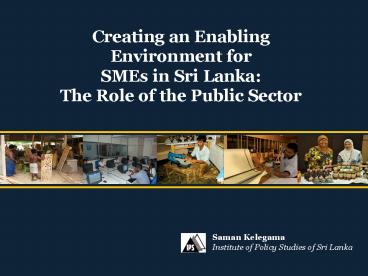Creating an Enabling Environment for - PowerPoint PPT Presentation
1 / 16
Title:
Creating an Enabling Environment for
Description:
Creating an Enabling Environment for SMEs in Sri Lanka: The Role of the Public Sector Saman Kelegama Institute of Policy Studies of Sri Lanka 1. – PowerPoint PPT presentation
Number of Views:34
Avg rating:3.0/5.0
Title: Creating an Enabling Environment for
1
Creating an Enabling Environment for SMEs in Sri
Lanka The Role of the Public Sector
Saman Kelegama Institute of Policy Studies of
Sri Lanka
2
1. Quick Take Policy Framework
2. Key Issues
3. Role of the Public Sector
4. Key Action Areas
5. Way Forward
3
- SMEs in Sri Lanka quick take
- How many SMEs in Sri Lanka? difficult to
quantify, no survey - Approx 70 of all enterprises are SMEs (MoFP)
- 91 of industrial establishments are SMEs (ASI
2008) - Contributes to around 26 of employment in
industries - Of 4,700 exporters, nearly 80 are SME suppliers
(EDB)
4
- Current framework for the development of SMEs in
Sri Lanka - GOSL Vision for the Future (2010)
- Implement a process to upgrade 5000 small-scale
enterprises to medium-level and 200 medium-scale
enterprises to large-level every year - Establishment of entrepreneurial centers to
encourage small and medium scale entrepreneurs - National Strategy for SME Sector Development -
White Paper December 2002 - Issues highlighted in 2002 SME White Paper are
still relevant today - Draft SME Policy 2010 with JICA Consultant
attached to NEDA
5
- SMEs in Sri Lanka Key Issues
- Lack of widespread Business Development Services
(BDS) providers - Constraints in access to finance (both demand and
supply-side issues) - SME owners need better managerial capability,
strengthen entrepreneurial potential - Productivity improvement and access to technology
- Improved access to markets (better linkages in
with local and foreign value chains
subcontracting, etc.)
6
Rationale for Public Sector Support
7
- Role of the Public Sector
Public Support
Objectives
8
Regulatory Environment
- Tax/labour legislation, competition policy
- Registration/licensing/administrative fees
- Commercial law/intellectual property rights
- Infrastructure connectivity roads, transport,
communication, IT, etc. - Regulatory compliance should be SME friendly
9
- Access to Finance
- Banks strong focus on collateral/security-based
lending. (Need to move to risk/cashflow-based
lending) - Risk averse in lending to SMEs, particularly
long-term capital. Working capital is less of an
issue - Branch officers unable to evaluate loan
applications with an SME-lens - Lack of SME-friendly credit rating/scoring scheme
- Previous evidence of concessionary loan schemes
low disbursement rates banks keen to promote
their own products?
10
Business Development Services
- Information services
- Management training/Entrepreneurship
- Subcontracting activities
- Standards
- Project preparation
- Incubators
- Markets
- Private-public partnerships
- Technology/machinery
11
SME Policy formulation looking East
- Countries in the Asian region have been found to
share similar constraints in the SME sector as
Sri Lanka - But they have far more robust SME development
policies whereas Sri Lanka does not - Thailand ? SMEs Promotion Plan (2007-2011)
- Philippines ? National SME Development Plan,
Magna Carta for SMEs - ASEAN? Policy Blueprint for the ASEAN SME
Development Decade 2002-2012 - Need to learn from the best practices in these
countries in developing a robust and
comprehensive SME plan for Sri Lanka
12
Access to Finance Examples
13
Key action areas
- Expansion of BDS providers across the country,
training in business facilitation, building SME
management skills, accounting/finance skills,
etc. - Improving SMEs access to and utilization of
technology (leverage on the Vidatha centres
across the country?) - SME access to financing survey/study
- Move forward faster on a National SME Policy
with an apex body that brings all stakeholders on
board
14
Way Forward
15
Way Forward
- Larger enterprises could be given incentives for
incorporating domestic SMEs more in their supply
chains - Direct tax concessions based on some formula of
the value of inputs procured from SMEs - Indirect national recognition scheme (awards)
for large enterprises that demonstrate the best
supply chain linkages with SMEs
16
Thank You
Web - www.ips.lk Blog Talking Economics -
www.ipslk.blogspot.com Twitter - _at_TalkEconomicsSL































